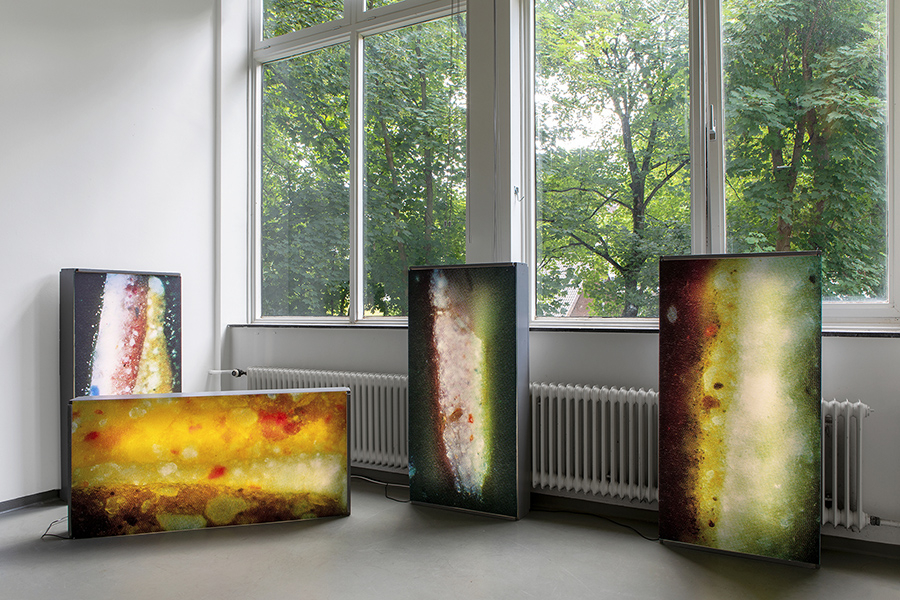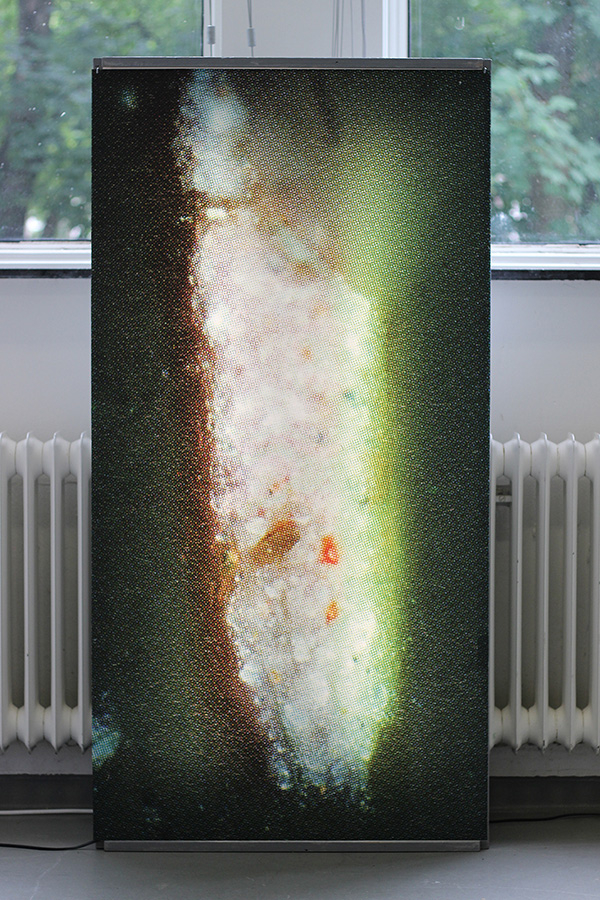Naturezas Mortas, 2022
Jan van Eyck Academie, Maastricht



Impressão Inkjet, Backlight / Inkjet Print, Backlight
70 x 140 x 25 cm cada / each
_________________________________________________________________________________
[PT] Ampliações de cinco pinturas de natureza morta da coleção do Rijksmuseum de Amsterdã são apresentadas em backlights. Pintadas no século XVII, as seções microscópicas mostram vestígios do pigmento de laca vermelho translúcido feito a partir de matéria orgânica. Os dois ingredientes mais populares na época para a fabricação da tinta vermelha constam no inventário da Companhia das Índias Ocidentais como dois dos produtos mais caros importados do Brasil: a cochonilha e o pau-brasil.
A cochonilha é um inseto parasita presente em diferentes espécies de cactos, cujo pigmento é extraído a partir da maceração dos insetos. Já a produção da tintura a partir do pau-brasil era feita através da raspagem e cozimento da casca da árvore. Após extraído da colônia holandesa em Pernambuco por africanos e indígenas escravizados, o pau-brasil era armazenado no presídio de Amsterdã, onde presos eram condenados ao trabalho forçado de raspagem das toras. Na segunda metade do século XVII, a prisão de Amsterdã detinha o monopólio de raspagem de pau-brasil para a fabricação de corante na Holanda, o que lhe rendeu o nome Rasphuis (casa de raspagem).
A ampliação dessas cinco pinturas, ao mesmo tempo que abstrai a representação realista da natureza em formas similares a paisagens geológicas, revelam uma outra espécie de realismo enterrada em sua materialidade: a natureza morta por trás das naturezas mortas.
_________________________________________________________________________________
[EN] Enlargements of five still life paintings from Amsterdam’s Rijksmuseum collection are presented in backlights. Painted during the 17th century, the microscopic cross-sections show traces of the translucent red lake pigment made from organic matter. The two most popular ingredients at the time for the manufacture of red lake are listed in the West India Company’s inventory as two of the most costly products imported from Brazil: cochineal and Brazilwood.
The cochineal is a parasitic insect present in different species of cactus, whose pigment is extracted by crushing the insects’ bodies. The production of paint from Brazilwood, on the other hand, was made through a process of rasping and cooking the bark of the tree. After being extracted from the Dutch colony in Pernambuco, Brazil, by enslaved Africans and indigenous people, the Brazilwood was stored in the prison of Amsterdam, where prisoners were sentenced to forced labor of rasping the logs. In the second half of the 17th century, the prison of Amsterdam held the monopoly on rasping Brazilwood for the manufacture of dyes in The Netherlands, which earned it the name Rasphuis.
The enlargement of these five paintings, while abstracting the realistic representation of nature into geological looking landscapes, reveals another kind of realism buried in their materiality: the dead nature behind the nature morte paintings.
_________________________________________________________________________________
Lista de Pinturas / List of Paintings:
Still life with flowers, 1625-1630
Balthasar van der Ast
Seção de tinta ampliada da pétala de íris roxo, luz incidente normal, ampliação 640x
Paint cross-section of a purple iris, normal incident light, magnification 640x
Banquet still life with roses, 1665
Abraham van Beyeren
Seção de tinta ampliada da pétala de rosa, luz incidente normal, ampliação 200x
Paint cross-section of a pink rose, normal incident light, magnification 200x
Still life, 1660-1690
Abraham van Beyeren
Seção de tinta ampliada da laranja, luz incidente normal, ampliação 500x
Paint cross-section of an orange, normal incident light, magnification 500x
Festoon of fruits and flowers, 1660-1670
Jan Davidsz de Heem
Seção de tinta ampliada da uva azul, luz incidente normal, ampliação 400x
Paint cross-section of a blue grape, normal incident light, magnification 400x
Still life with flowers in a Wan-Li vase, 1619
Ambrosius Bosschaert
Seção de tinta ampliada da rosa de cem pétalas, luz incidente normal, ampliação 640x
Paint cross-section of a pink cabbage rose, normal incident light, magnification 640x